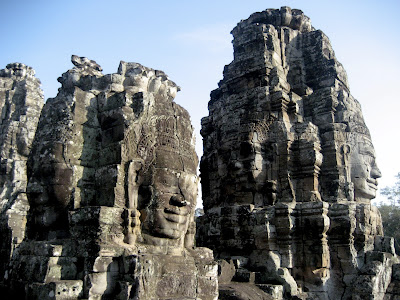Sunday I continued my travels to many more temples. From the UNESCO World Heritage website:
"Angkor is one of the most important archaeological sites in South-East Asia. Stretching over some 400 km2, including forested area, Angkor Archaeological Park contains the magnificent remains of the different capitals of the Khmer Empire, from the 9th to the 15th century. They include the famous Temple of Angkor Wat and, at Angkor Thom, the Bayon Temple with its countless sculptural decorations."
To read more about the sites I visited, click here:
Above is a terrace that was essentially a dance area for traditional Apsara dancers. Below are some Cambodians dressed in traditional Apsara costumes...
 |
Midday I stopped behind one of the temples and rested under a thatched hut. This woman and her family keep the grounds clean. I was drenched in sweat but she was dry and wearing a lined coat. Go figure! Here she is preparing a traditional Khmer lunch:
Many of the temples have small shrines like this one in the central chamber.
Above is a long bridgeway over a moat that serves as the entrance to one of the temples. Originally there were 22 carved deities on each side of the bridgeway, times two bridgeways for a total of 88 individual carved deities. Each one was about twice the size of myself. Below was are the only two remaining heads. Most likely these are reproductions. In two and a half days of exploring the vast temples here, there was not a single original Buddha head as pillaging was rampant after the fall of the Khmer empire.
this shot is taken through a collapsed, open portion of a temple ceiling and shows the enormity of the trees that have consumed major portions of these temples. Many trees have been cut down but several have been retained due to the natural beauty of the consumptive growth. The two images below this one are some of the best examples of the beautiful overgrowth of trees on the temples.
I was amazed at how many tourists followed each other crowding around the same well-beaten temple locales. By simply walking where others were not, I found many beautiful spots like the one below. I sat here for quite some time - completely alone - contemplating the ancients who had occupied these vast complexes.
Child labor is a major problem in Cambodia and, unfortunately, is rampant throughout the temples with parents paying large bribes to the authorities to sell on the temple grounds. Children were selling everywhere I turned throughout the day, many between the ages of 6-10 years. What makes matters worse is that many tourists fuel this problem by having pity on the children and buying from them. The vast majority of these children do not attend school at all and buying from them only encourages their underage labor and robs them of an education and a better future. The children are also coached to be quite aggressive in their tactics. Here a young boy is selling to monks:
These adult men made me take pause and were a "breath of fresh air" amidst the rampant underage selling and begging. They did not beg for money and, instead, filled the temple area with beautiful, traditional Khmer music. Read the message on their sign...
And finally, the Bayon temple! A few years ago, a dear friend gave me a beautiful framed print of this temple and it hangs today on my apartment wall in New York. I have dreamed for years of visiting this temple. The first day I arrived at this temple, I lifted my camera to take a photo that I had wanted to capture for years and my camera battery promptly died! So I came back the next day...
There are dozens of these carved Bayon pillars with each pillar having 4 heads. The pillars are each about 50-70 feet tall. A mind-boggling achievement.































I've stolen a bunch of these and put some up on Facebook...they are amazing! Thanks for sharing. :-)
ReplyDelete